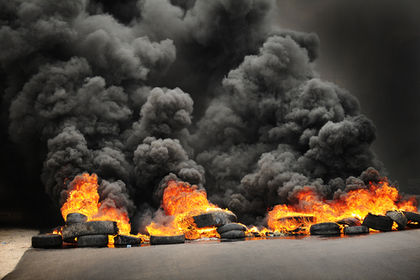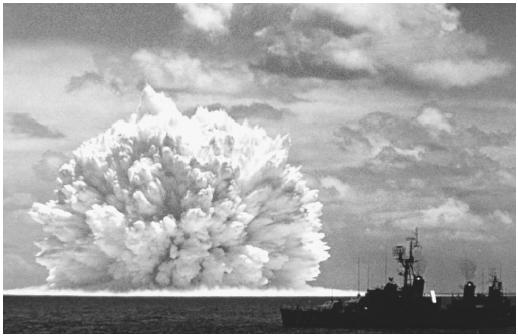Explosions

An explosion is a sudden, violent change of potential energy to work, which transfers to its surroundings in the form of a rapidly moving rise in pressure called a blast wave or shock wave. The shock wave can cause substantial damage. Potential energy may exist in either of three forms before an explosion occurs: nuclear , chemical, or physical. Generally, nuclear explosions are much larger and more destructive than chemical or physical explosions. Chemical explosions are more frequent than nuclear or physical explosions. Although chemical explosions are usually deliberate, they may also occur accidentally. Large physical explosions are relatively rare and usually accidental.
Nuclear Explosions
Nuclear explosions may be caused by either fusion or fission reactions. In a fusion reaction, the nuclei of two small atoms combine to form a single larger atom, sometimes accompanied by a neutron. The mass of the products of the reaction is less than the mass of the reactants, and that difference in mass is converted to energy according to Einstein's well-known equation E = mc 2 where E is the energy produced, m the mass converted to energy, and c the speed of light. The speed of light is very large, and only a small amount of mass must be converted to result in a significant explosion.
In a fission reaction, a single large atom, such as uranium, is bombarded with neutrons, causing the nucleus of the atom to split into two smaller nuclei and several neutrons. The combined mass of the product atoms and neutrons is less than the mass of the original atom, and the mass loss is converted to energy according to Einstein's equation. The neutrons produced by the fission reaction cause other large atoms to fission, and their neutron production causes still other atoms to fission, leading to a chain reaction that continues exponentially (i.e., 2, 4, 8, 16, 32, 64…). The entire process is very rapid, taking only a few millionths of a second. The resulting energy production heats the surrounding air and causes it to expand in the form of a blast wave.

Both fusion and fission reactions can be used in bombs. The fusion reactions require a very high temperature to get started, so they are initiated by fission reactions. (When controlled at slower rates in nuclear reactors, fission reactions are used to produce power and additional nuclear fuel.)
Chemical Explosions
Chemical explosions may be either decomposition or combination reactions. In either case, the reaction is exothermic and the energy released by the reaction is partially converted to work. Decomposition reactions occur in materials such as trinitrotoluene (TNT) and nitroglycerine. The molecules of these materials contain oxygen. When the molecule decomposes, the products are combustion gases, which are produced at high temperatures. The volume of the gases is much larger than the volume of the explosive, generating high pressures at the reaction zone. The rapid expansion of the gases forms the shock wave that provides the explosive effect. Even some hydrocarbons that have no oxygen in their molecules, such as acetylene, can decompose explosively.
Combination reactions require that two or more components react together exothermically to produce hot gases. Some examples are ammonium nitrate and fuel oil (ANFO), gunpowder (potassium nitrate, carbon, and sulfur), and fireworks. In these explosions, the reactants that make up the explosive must be carefully mixed to assure that the reaction will continue.
The damage caused by an explosion depends partly on how fast the explosive reaction occurs. Decomposition reactions generally occur much faster than combination reactions. They are more likely to be used for military applications because they are more destructive. They also have a stronger shattering effect (called brisance) than combination reactions. Combination explosions are frequently used in mining operations because they have lower brisance and occur at slower rates.
There is a special case of explosion known as a vapor cloud explosion that can occur when a fuel (such as ordinary propane) is mixed with the atmosphere. If the cloud is ignited, the burning rate may be fast enough to form a shock wave. Although the overpressure in the shock wave may not be very high compared to other explosions, it is strong enough to damage or destroy structures. In a vapor cloud explosion, the result is called a deflagration if the shock wave moves slower than the speed of sound and a detonation if the shock wave moves faster than the speed of sound. Detonations are more destructive than deflagrations because of their stronger shock waves.
It should be kept in mind that explosives are generally unstable compounds. Once the exothermic decomposition or combination reaction is started, the temperature rises and the reaction accelerates; it usually cannot be stopped.
Physical Explosions
Physical explosions are those in which no chemical or nuclear reaction occurs. The most frequent example is the rupture of a vessel whose contents, either gas or liquid, exist under high pressure. If the containing vessel bursts, its contents are free to expand and a shock wave is formed. Even a common automobile tire can explode if it is highly overinflated.
Liquids that have a normal boiling point well below ambient temperatures are sometimes stored (under their own vapor pressure) at pressures well above atmospheric pressure. If the tank holding the liquid bursts, part of the liquid vaporizes extremely rapidly and expands, forming a shock wave. This process is called a boiling liquid expanding vapor explosion (BLEVE) and the resulting explosion can be very destructive.
Explosions can be used for constructive purposes, such as mining and road building; for entertainment, such as fireworks; or for destructive purposes, such as military weapons and terrorist bombs. They may be either deliberate or accidental. Explosive materials must always be handled with extreme care to prevent accidents. Such caution must be exercised with not only industrial explosives, but also commonly encountered materials such as fireworks, laboratory and industrial chemicals, and flammable gases.
SEE ALSO Fire, Fuels, Power Plants ; Fireworks ; Kinetics ; Nuclear Fission ; Nuclear Fusion ; Thermodynamics .
J. Reed Welker